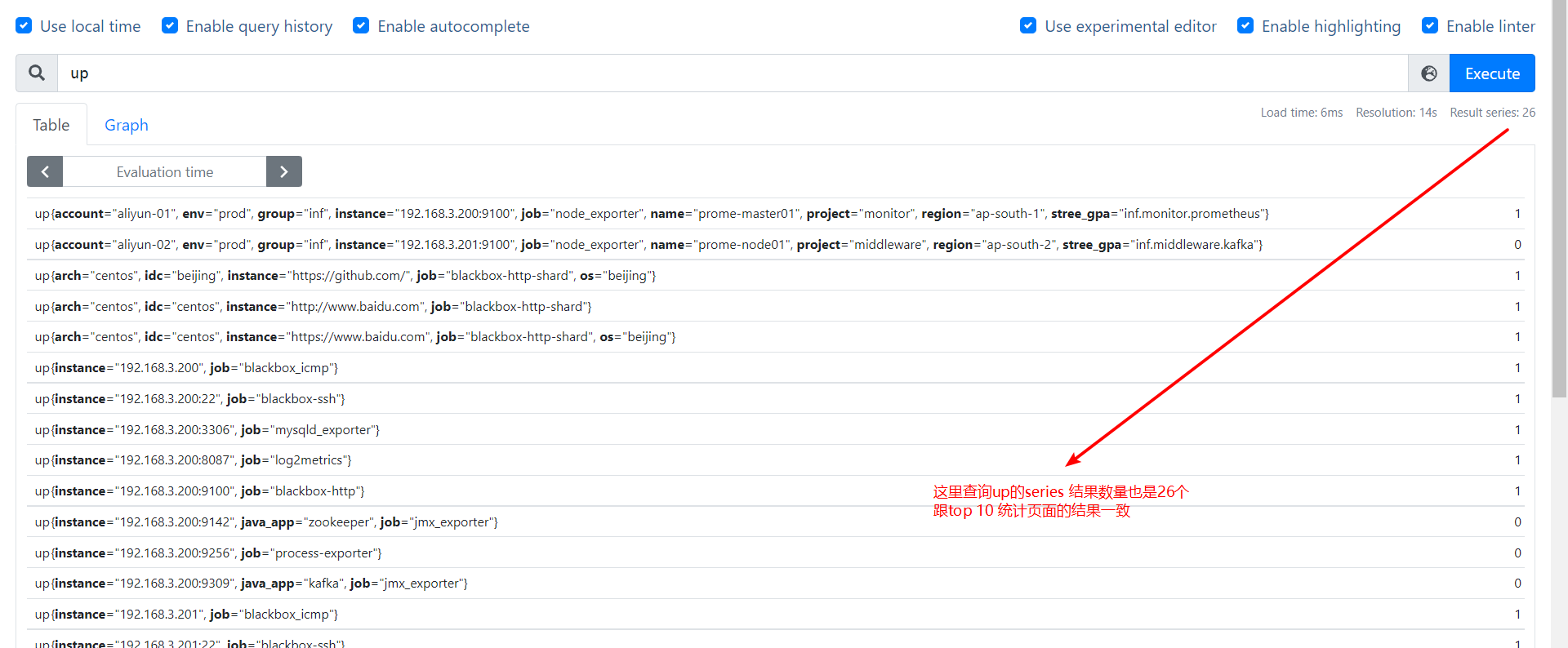获取采集端的高基数metrics的tsdb页面解析 tsdb统计函数Stats源码解读 Top 10 label names with value count: 标签中value最多的10个 Top 10 series count by metric names: metric_name匹配的series最多的10个 Top 10 label names with high memory usage: 标签消耗内存最多的10个 Top 10 series count by label value pairs: 标签对数量最多的10个 func ( api * API) serveTSDBStatus ( * http. Request) apiFuncResult { s, err := api. db. Stats ( "__name__" ) if err != nil { return apiFuncResult{ nil , & apiError{ errorInternal, err} , nil , nil } } metrics, err := api. gatherer. Gather ( ) if err != nil { return apiFuncResult{ nil , & apiError{ errorInternal, fmt. Errorf ( "error gathering runtime status: %s" , err) } , nil , nil } } chunkCount := int64 ( math. NaN ( ) ) for _ , mF := range metrics { if * mF. Name == "prometheus _tsdb_head_chunks" { m := * mF. Metric[ 0 ] if m. Gauge != nil { chunkCount = int64 ( m. Gauge. GetValue ( ) ) break } } } return apiFuncResult{ tsdbStatus{ HeadStats: HeadStats{ NumSeries: s. NumSeries, ChunkCount: chunkCount, MinTime: s. MinTime, MaxTime: s. MaxTime, NumLabelPairs: s. IndexPostingStats. NumLabelPairs, } , SeriesCountByMetricName: convertStats ( s. IndexPostingStats. CardinalityMetricsStats) , LabelValueCountByLabelName: convertStats ( s. IndexPostingStats. CardinalityLabelStats) , MemoryInBytesByLabelName: convertStats ( s. IndexPostingStats. LabelValueStats) , SeriesCountByLabelValuePair: convertStats ( s. IndexPostingStats. LabelValuePairsStats) , } , nil , nil , nil }
} metrics := & maxHeap{ } labels := & maxHeap{ } labelValueLength := & maxHeap{ } labelValuePairs := & maxHeap{ } numLabelPairs := 0 metrics. init ( maxNumOfRecords) labels. init ( maxNumOfRecords) labelValueLength. init ( maxNumOfRecords) labelValuePairs. init ( maxNumOfRecords) 把所有非空的标签算入统计 labels,值是e中id-set的长度 labels这个 最大堆统计的就是 Top 10 label names with value count,代表 标签中value最多的10个 for n, e := range p. m { if n == "" { continue } labels. push ( Stat{ Name: n, Count: uint64 ( len ( e) ) } ) } 遍历内层的map,如果name和传入的label一致,则加入metrics最大堆统计 metrics这个 最大堆统计的就是 Top 10 series count by metric names: metric_name匹配的series最多的10个 for n, e := range p. m { ... size = 0 for name, values := range e { if n == label { metrics. push ( Stat{ Name: name, Count: uint64 ( len ( values) ) } ) } } }
遍历内层的map,把name=value做统计算入labelValuePairs最大堆统计 labelValuePairs这个 最大堆统计的就是Top 10 series count by label value pairs: 标签对数量最多的10个 for n, e := range p. m { ... for name, values := range e { labelValuePairs. push ( Stat{ Name: n + "=" + name, Count: uint64 ( len ( values) ) } ) } }
遍历内层的map,计算标签的value字符串长度 size,推入labelValueLength 最大堆统计 labelValueLength这个 最大堆统计的就是Top 10 label names with high memory usage: 标签消耗内存最多的10个 for n, e := range p. m { if n == "" { continue } size = 0 for name, values := range e { size += uint64 ( len ( name) ) } labelValueLength. push ( Stat{ Name: n, Count: size} ) }
func ( m * maxHeap) get ( ) [ ] Stat { sort. Slice ( m. Items, func ( i, j int ) bool { return m. Items[ i] . Count > m. Items[ j] . Count} ) return m. Items
} 获取采集端的高基数metrics的tsdb页面解析 tsdb统计函数Stats源码解读 依赖倒排索引统计 是基于内存中的倒排索引 算最大堆取 top10 









